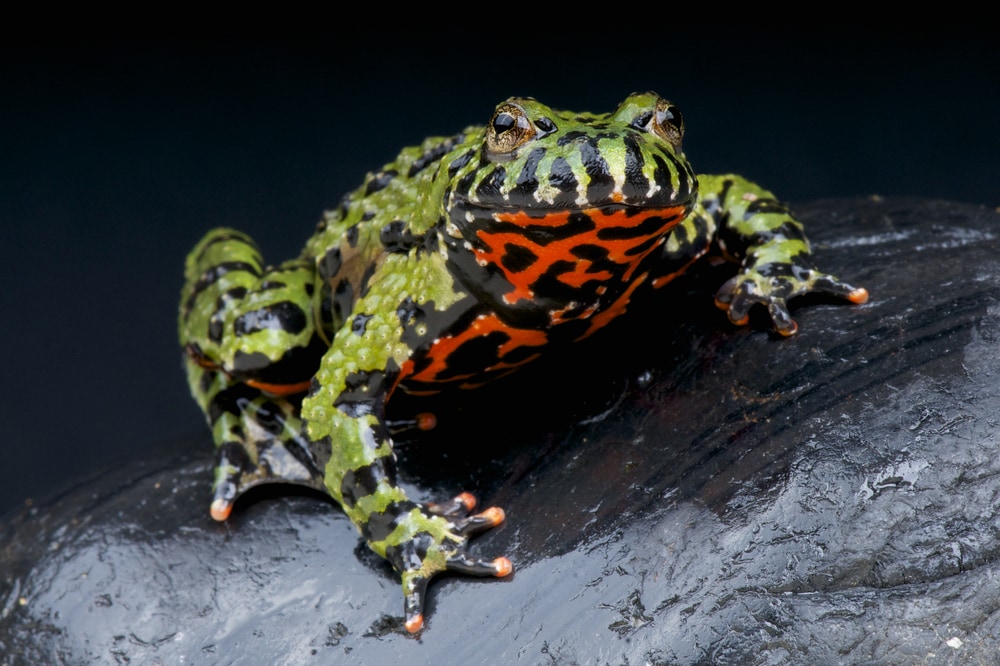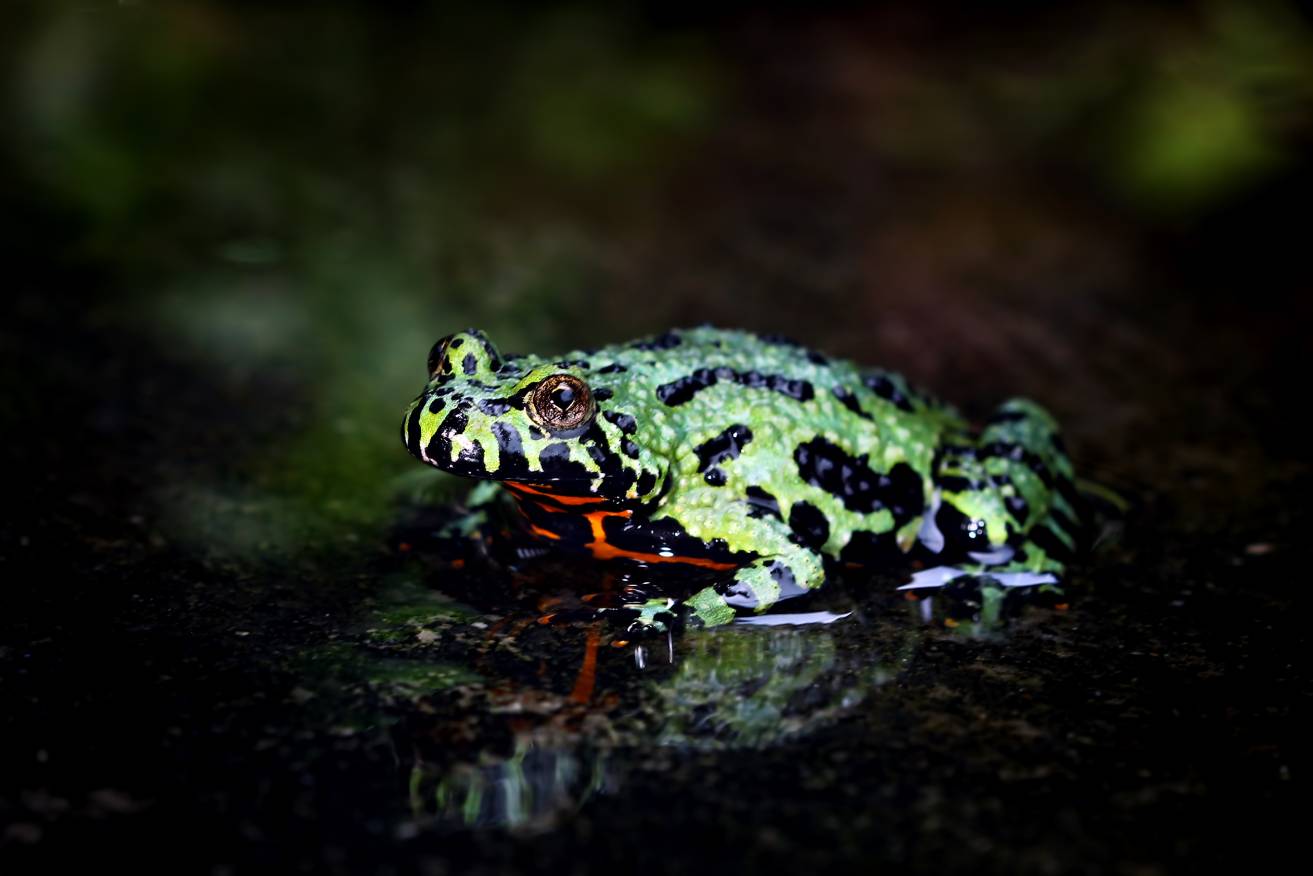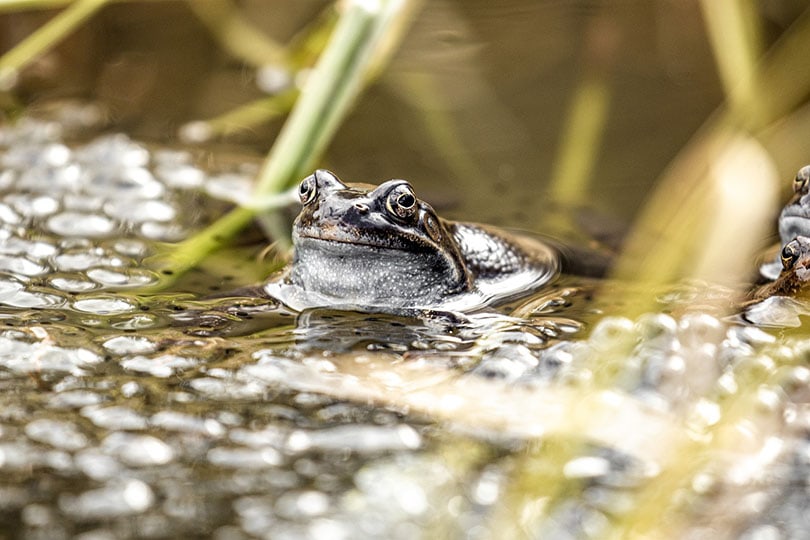
Dogs and cats are great, but sometimes you want something a little more off the beaten path in terms of a pet—sometimes, you just need a pet frog.
Frogs are incredibly cute in their own way, and they tend to be much easier to care for than more traditional pets. However, before you bring one home, you should educate yourself on what, exactly, it takes to successfully raise one of these amphibians. This guide will help you do just that.
Frog Facts
First, it’s not so simple as just buying a frog. There are a ton of different frog species out there, and each has different needs and requirements, so you’ll need to research before you whip out your credit card.
Different frogs can require completely different environments, so take everything on this list to be a guideline rather than a hard-and-fast rule. Buy a few books, ask knowledgeable breeders—do whatever you need to do to properly prepare yourself for owning your first frog.
Your frog’s life span will depend on a variety of factors, including their species and your ability to properly care for them. On average, though, you can expect to commit 3 to 10 years to this pet, although it’s not unheard of for these animals to live much longer.
Their sizes vary wildly as well, ranging from 1.5 to 5 inches. The overall size isn’t so important, as long as you know how big they’ll be once fully grown, as that will allow you to buy a tank of a suitable size.
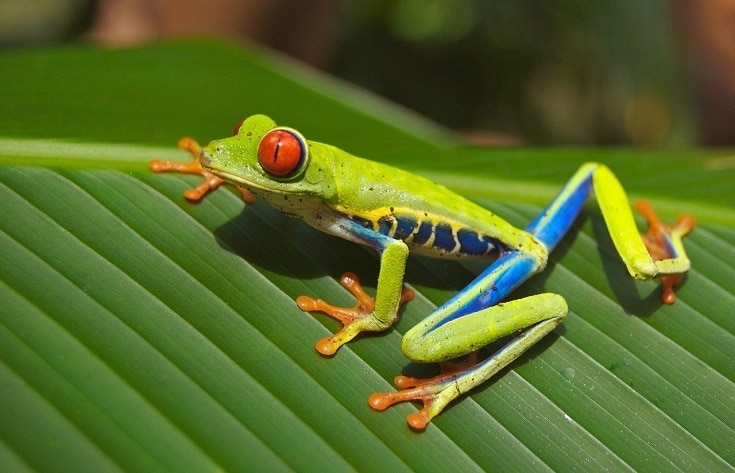
Are Frogs Good Pets?
This is a tricky question to answer. The best response we can give is yes, but they’re not for everyone.
The good news is that if you’re attracted to the idea of keeping a frog as a pet, then you’re likely in the group that would enjoy such a thing. However, if you have more “traditional” ideas about how a pet should behave—if you’re expecting cuddliness, affection, and any sort of regard for your existence—then frog ownership will likely leave you disappointed.
Most frog species are nocturnal, so expect them to be more active after the sun goes down. This means you should research whether the species that you have your eye on tends to be vocal, or else your new pet could keep you up at night.
By and large, though, frogs are low-maintenance pets, at least when compared to cats and dogs. They don’t take up much space, require little in the way of daily care, and can be inexpensive to keep (although that’s not always the case). If that sounds like a good pet to you, then a frog may be just what the veterinarian ordered.
Where Can I Get a Pet Frog?
This will depend in large part on what kind of frog you want.
If you want just any frog, then most pet stores sell them, and they’re relatively inexpensive. Your options might be limited, though, and it’s likely that you’ll get something of a generic frog.
There are a few species that are very rare and tend to be prized among collectors (luxury frogs, if you will). These will naturally be much more expensive than any amphibian that you’d find at your local pet store, and you’ll almost certainly have to go through a specialized breeder to find one.

Capturing wild frogs is generally discouraged, as they’re surprisingly dangerous animals (many of them carry salmonella, and in some areas, you may come across lethal poison dart frogs).
There are also rescue groups out there that specialize in exotic pets like reptiles and amphibians. You might be able to find a high-end frog for cheap if it had to be surrendered by its owner. Regardless, you can save the life of one frog without contributing to putting others in forced captivity.
How Much Does It Cost to Own a Pet Frog?
This will depend almost entirely on what kind of frog you end up buying and how swanky of a setup that you provide them with.
It’s possible to buy a frog, terrarium, and all the accessories that you absolutely need for less than $100. This will be a fairly barebones setup with a common species, to be sure, but this example is just to prove that frog ownership is possible on the cheap.
On the other hand, if you want a more exotic species and you plan on pampering them with high-end housing, it will cost you several hundred dollars more, possibly running into the thousands.
Almost all your major expenses are going to come at the beginning, as the recurring costs of frog ownership are quite low. They mostly eat insects, which tend to be cheap, and depending on the species, they may not eat many of those, anyway.
What Kind of Home Does My Pet Frog Need?

The Habitat
This depends on the type of frog that you own. There are three basic types of habitats that you’ll encounter: arboreal, terrestrial, and aquatic.
Tree-dwelling species will need an arboreal enclosure. These tanks are much taller than they are wide, allowing you to put vines, branches, and other decorations inside for your frog to climb on. They also do better in terrariums than aquariums (all this means is you want a tank with vents at the bottom).
Larger frogs or toads or any species that doesn’t jump that high might prefer a terrestrial cage. These look like basic aquariums, and they’re wider than they are tall. You can use a terrarium or aquarium for land-based frogs, but be sure to put a lid on the top so they don’t hop right out.
Aquatic species live in the water. You’ll need an actual aquarium for these, as they will be full of water. The size of the tank will depend on how many frogs and what species you’re keeping, but anything less than 10 gallons is likely unacceptable.
Substrate
The proper substrate will vary depending on the species. The most common types are soil, coco fiber, sand, coco-husk fiber, and moss. Read up on the species that you plan to purchase, and find out what substrate form most closely matches their preferred environment.
Regardless of which type you purchase, opt for a non-particulate substrate. That will reduce the risk of impaction, which is when your frog accidentally consumes substrate that they can’t digest, causing it to build up in their digestive tract. Impaction often kills frogs, so it’s something to be avoided if possible.
You’ll also need to decide whether you want live plants in your frog’s tank. If you do, you’ll need to find something suitable for growing vegetation. You’ll also need to figure out a way to ensure that the water drains from the bottom of the tank, preventing your substrate from getting too soggy.
Heat and Lights
Most frogs require their tanks to be at a certain temperature, so you’ll likely need to set up a heating pad or basking lamp to keep their tank at that temperature. Some species require UV-B lighting as well, so if you adopt one of those, you’ll need a special lamp.
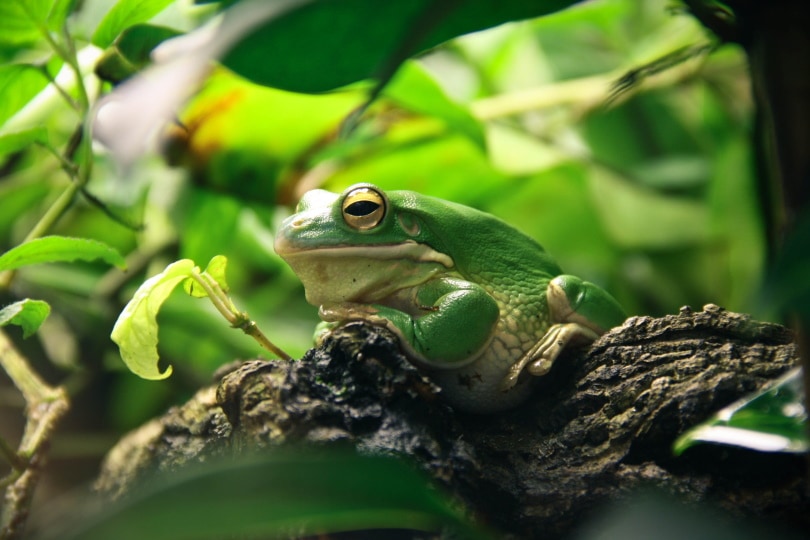
Many frogs need plenty of humidity as well. You could mist it yourself, but that’s time-consuming and annoying. Instead, you might want to invest in an automated misting system or a fogger.
As for light, you may not need any if the tank is close to a source of natural light. The idea here is to give your frog some idea of day and night cycles; if they won’t have access to the sun, you’ll need a lamp with a day and night setting.
What Should I Feed My Pet Frog?
One of the biggest mistakes that amateur frog owners make is only feeding their frogs crickets. While crickets are a suitable snack for frogs, they don’t have enough nutrition for your pet to live on. Most frogs eat a wide variety of insects in the wild, so you’ll want to mimic that variety as much as you can.
You’ll likely have difficulty giving your frog something new all the time, though. In that case, vitamin supplements (especially calcium) are used. These come in powdered form, and you simply sprinkle the vitamins on the insects before feeding them to your frogs.
In addition to crickets, you might want to offer your frog fruit flies, worms, Dubia roaches, and even larger mammals like mice if you have a big enough frog. Ultimately, you’ll want to research your frog of choice to find out what they like to eat.
Juvenile frogs should be fed every day, while fully mature adults can get by on several meals a week. Be careful about portion sizes, as frogs will keep eating until they become seriously ill. Limit your frog’s meals to five or six insects unless you notice them struggling to deal with that amount.
All frogs need plenty of water, but it’s absolutely vital that you make sure that the water you use is free of chlorine and other toxins. The problem is that frogs have semi-permeable skin, so they’ll absorb everything that’s in the water, and many of those chemicals are lethal to them. You’ll likely need to buy special water-conditioning agents to make your tap water suitable for your pet.

How Do I Take Care of My Pet Frog?
Handling
Handling your frogs with bare skin is generally discouraged. Your skin can be full of chemicals like soap, fragrances, lotions, and the like, and since frogs have semi-permeable skin, they can get seriously ill from ingesting those substances. What’s more, some frogs carry salmonella or secrete toxins, so not touching them protects you as well.
If you insist on holding your frog with your bare hands, wash them first (and be sure to rinse them off thoroughly to remove all the soap residue). Don’t bother drying them, though, as your hands should be wet whenever you handle a frog.
It’s best to use disposable, non-powdered vinyl gloves whenever you need to pick up your pet. This protects all parties involved, and it keeps your hands clean.
There’s a proper way to pick up and hold a frog. Put your thumb on its back, just below its head, and use your other fingers to gently scoop it up. While it’s in your hand, its weight should be supported by your fingers, while your thumb gently prevents it from escaping. Whatever you do, don’t squeeze too hard.
An alternative to using your hands is to buy a fish net or a plastic spoon. Either of these is a great way to put your frog in a secondary tank while you clean their primary habitat.
Exercise
You don’t need to buy a leash to take your frog for a walk or anything like that, but it is essential that your pet has enough room in their tank to move around. They’ll handle their own exercise needs, but only if they have room to do so.
It’s also helpful to have plenty of decorations for your frog to climb around on.

Grooming
Frogs don’t have much in the way of grooming needs (don’t even bother trying to brush them, as it will likely end poorly for both of you). Many species will shed skin from time to time; there’s nothing that you need to do about this, other than remove the dead skin once they’re finished.
Habitat Cleaning
You should clean any messes as they occur, but frogs are generally clean creatures. However, living in humid, moist environments can cause mold to grow over time, so it’s essential that you give their habitat a thorough cleaning at least once a month.
Don’t use any household cleaners or other harsh chemicals to clean the habitat. You can purchase special cleaning formulas for frogs, or you can just use hot water and elbow grease.
Start by picking up your frog and transferring them to their temporary enclosure. Then, remove all the decorations and rinse them with hot water (use room temperature water on live plants). Wipe them down with a towel and set them aside.
You can remove any dishes and rinse them out with hot water as well. The substrate should be removed and replaced. While you’re here, examine logs, stumps, and the like to see if they show signs of rot. These decorations need to be replaced every few years for that reason.
After everything is out of the tank, rinse it out with hot water and then use a towel to wipe everything down. Be sure to remove any stuck-on gunk; if necessary, let it soak in the hot water for a few minutes to make it easier to dislodge.
When you’re done with this step, return everything to the tank (put the frog in last). You’ll need to mist things thoroughly, as the cleaning process tends to dry out the environment.
How Do I Know if My Pet Frog Is Sick?

Even if you’re the most dedicated and conscientious frog owner in the world, your pet might get sick occasionally. Unfortunately, few vets specialize in amphibians, so if you can’t remedy the problem yourself, your frog’s prognosis might be grim.
Usually, the cause of their illness lies in their living conditions. You might have the tank set at the wrong temperature, you might have given them water filled with chemicals, or you might have neglected regular cleaning of the tank. If the problem is obvious, remedying it is a good first step in getting your frog back on the highway to health.
Beyond that, here are a few common health issues that you should be on the lookout for:
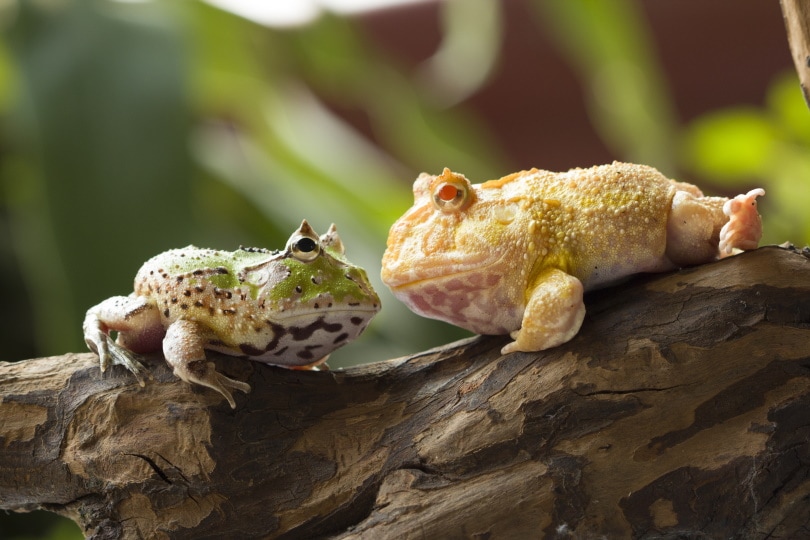
Conclusion
If you want an unconventional pet that’s easy (and rewarding) to care for, then consider adding a frog to your menagerie. These adorable amphibians are interesting and full of personality, and they require much less upkeep than a more traditional pet.
Best of all, you’ll never have issues with flies, moths, or mosquitos if you have a guard frog on the premises!
Featured Image Credit: Frank B Yuwono, Shutterstock


